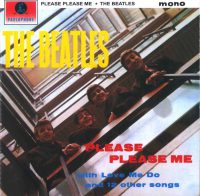The other was Introducing... the Beatles, on Vee-Jay:
Notice how Ringo's hair on the Introducing... the Beatles album cover is not yet really a "mop top." The photo must have been taken just after Ringo replaced Pete Best as the Beatles' drummer. Ringo had moved over to the Beatles from Rory Storm and the Hurricanes. Here's what Ringo looked like, pre-Beatles:
Introducing... the Beatles was not released by Capitol Records because Capitol had turned it down.
Capitol Records was the North American subsidiary of EMI, a British multinational music recording and publishing, electronics, device and systems manufacturing company headquartered in London. The record label Parlophone, the one which Beatles records came out on in Britain, was a sister label to Capitol in the U.S. So it was natural that Capitol had first dibs on releasing Beatles records in this country. But Capitol didn't "get" the Beatles — thought their popularity would not translate to this country — when their first crest of popularity arrived in England in 1963, and it passed on releasing its own version of the very first Beatles LP that came out on Parlophone.
At that point, Vee-Jay, a canny independent record label, picked up the rights to the album. After dithering during much of 1963, Vee-Jay released Introducing... the Beatles on January 10, 1964.
It's a kind of poetic justice that that happened. Vee Jay was known for its roster of "some of the most talented rhythm and blues artists of the era," according to Earl L. Stewart's African American Music: An Introduction (p. 210). For example, "Vee-Jay scored its first million seller in 1961 with the release of 'Duke of Earl' by Gene Chandler."
Vee-Jay's artists were mostly African American, although Vee-Jay was the first record company to release early hits by the Four Seasons. It released "Sherry," the Four Seasons' first No. 1 hit, in 1962, and several of the other early Four Seasons hits subsequently were released on Vee-Jay.
It was truly appropriate that the earliest Beatles music came out here on an R&B label such as Vee-Jay, because the early Beatles were inspired by black R&B and by early rock 'n' roll records by both black and white artists that R&B helped spawn.
Vee-Jay, which was African American-owned, released records by:
- The Dells
- The Spaniels
- The El Dorados
- The Impressions
- The Pips (later Gladys Knight and the Pips)
- Jerry Butler
- Dee Clark
- Betty Everett
- Priscilla Bowman
- Gene Chandler
- Jimmy Reed
- Memphis Slim
- John Lee Hooker
- The Five Blind Boys
- The Staple Singers
- The Highway QC's
- The Harmonizing Four
- The Sallie Martin Singers
- The Swan Silvertones
- The Gospel Harmonizers
- Comedian Dick Gregory
(I get this list from Earl L. Stewart's book and from Wikipedia.)
To be fair, the early Beatles' repertoire did not "mine" the music of black Vee-Jay artists the way it did the black artists of other record labels such as Smokey Robinson ("You Really Got a Hold on Me"), Chuck Berry ("Roll Over Beethoven"), Little Richard ("Long Tall Sally"), the Marvelettes ("Please Mister Postman"), etc.
But it's hard to see why not. After all, R&B, early R&R, soul, gospel, blues — it all came out of the same African American musical tradition, even when it was interpreted by white artists such as the Beatles, the Four Seasons, the Beach Boys, the Righteous Brothers, and the Rolling Stones.










